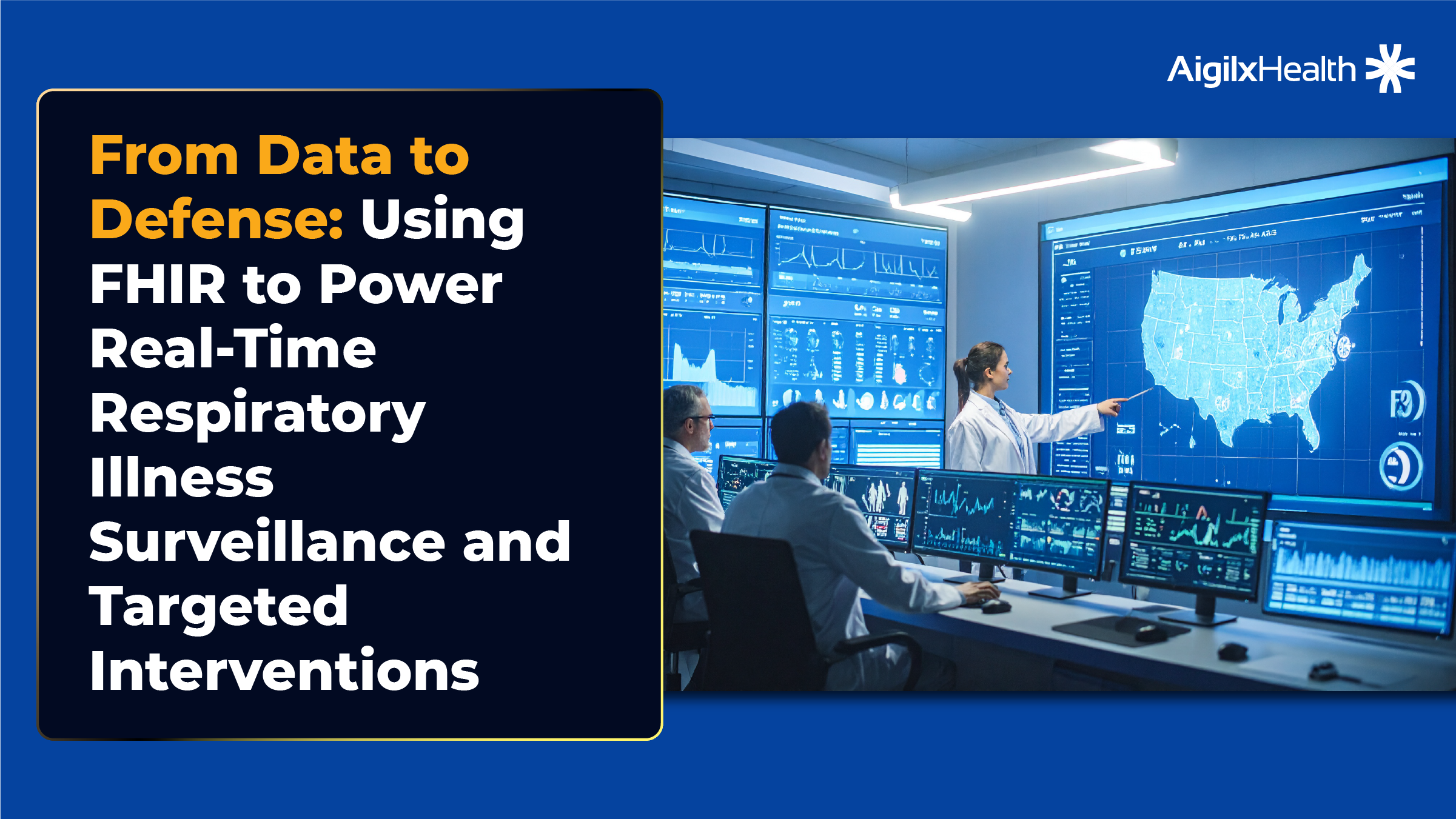From Data to Defense: Using FHIR to Power Real-Time Respiratory Illness Surveillance and Targeted Interventions
10 Sep

The Challenge of the 2025–2026 Respiratory Illness Season
As the United States enters the 2025–2026 respiratory illness season, healthcare systems and public health agencies face intensified pressure from a complex combination of pathogens, namely, influenza, RSV, COVID-19, and pertussis. Each brings unique risks and contributes to overlapping waves of demand on surveillance and response systems.
Yet, much of our surveillance infrastructure remains rooted in delayed, fragmented, and siloed methods. The CDC’s FluView Weekly U.S. Influenza Surveillance Report notes that most influenza activity indicators are reported with a lag of one to two weeks, undermining rapid response capabilities.
Moreover, the CDC’s RESP-NET (Respiratory Virus Hospitalization Surveillance Network), which tracks lab-confirmed hospitalizations for influenza, COVID-19, and RSV, depends on clinical testing and faces limitations such as under-testing, inconsistent provider practices, and diagnostic sensitivity, meaning the true burden of hospitalizations may be considerably higher than reported.
Collectively, these delays and gaps reduce real-time situational awareness, slowing outbreak detection and impairing equitable public health response, especially in a multi-pathogen environment where timing is everything.
Why Traditional Models Fall Short
Current surveillance models are mostly retrospective. They depend on manual data submissions, outdated interoperability frameworks, and reporting methods that vary by jurisdiction. This leads to:
- Missed opportunities: Outbreaks often escalate before alerts reach local agencies.
- Delayed response: Resources like vaccines or ventilators arrive after peak demand.
- Inequities in care: Communities with fewer reporting pipelines face greater risk of being overlooked.
In a multi-virus environment, where simultaneous waves of different pathogens are likely, a faster, more connected model is not optional; it is necessary.
FHIR as the Game-Changer
Fast Healthcare Interoperability Resources (FHIR) is redefining what’s possible in public health surveillance. Unlike older HL7 v2 systems that rely on batch uploads, FHIR provides:
- Structured, real-time data exchange across providers, labs, and agencies.
- Event-driven updates through FHIR Subscriptions that can trigger alerts as soon as cases are detected.
- Scalable workflows that can support multiple pathogens, geographies, and use cases simultaneously.
Because FHIR uses modern web APIs, it integrates easily with both clinical systems and non-clinical data sources, unlocking a true ecosystem view of population health.
Blueprint for a FHIR-Powered Respiratory Surveillance System
A modern surveillance platform, powered by FHIR, can include:
- FHIR Resources:
- Observation for lab results, test positivity, and vitals.
- Encounter for hospitalization and emergency visits.
- Subscriptions: Push notifications for new cases or abnormal results in real time.
- Bulk FHIR APIs: Export cohort data for cross-state and population-level analysis.
- CQL (Clinical Quality Language): Automated case detection and reporting logic aligned with CDC and WHO standards.
- Federated Surveillance Models: Data stays local while insights aggregate centrally, preserving privacy while enabling faster decision-making.
This blueprint allows surveillance teams to move from static dashboards to real-time, multi-pathogen monitoring and alerts.
From Detection to Intervention
Surveillance is not just about counting cases; it’s about guiding action. Real-time FHIR-powered detection enables:
- Targeted Outreach: Directing alerts and resources to affected zip codes or high-risk populations.
- Smarter Resource Allocation: Adjusting staffing levels, ventilator supply, or vaccine distribution before peak demand.
- Equity in Response: Linking surveillance with social determinants of health data ensures vulnerable communities are not overlooked.
For example, rapid identification of rising RSV admissions in paediatric wards can trigger earlier mobilization of respiratory therapists and supplies, weeks before traditional reports would surface the trend.
Where Aigilx Health Leads
Aigilx Health is helping healthcare systems and public health agencies move from data silos to real-time defense. With deep expertise in FHIR and respiratory illness data integration, Aigilx delivers:
- Operationalized architectures: End-to-end surveillance systems built and deployed in live environments.
- Comprehensive data integration: Closing gaps in timeliness, completeness, and equity of reporting.
- Governance and compliance: Ensuring interoperability aligns with CDC, ONC, and local privacy requirements.
Our work empowers CIOs, CMIOs, HIE leaders, and public health executives to make surveillance actionable, not just informational!!
The Outcome: From Static to Predictive
A FHIR-powered surveillance system transforms how organizations manage respiratory illness:
- From retrospective to predictive.
- From manual reporting to automated alerts.
- From fragmented silos to coordinated networks.
The result is faster outbreak detection, smarter allocation of resources, and more equitable protection of public health.
The 2025–2026 season is already here. Waiting for traditional reports means responding late. By building on FHIR, organizations can gain real-time visibility and deliver targeted interventions when they matter most.
Aigilx Health is the partner to accelerate this transition, bringing proven FHIR expertise, hands-on implementation experience, and a commitment to equity-driven surveillance.
Now is the time to shift from static data to dynamic defense!!
Use our Free FHIR Readiness Self‐Assessment
Discover your roadmap in minutes:
- Where You Stand Today: Evaluate your current API footprint, data models, and team expertise.
- FearBusting Insights: Get tailored guidance on mitigating common implementation risks and timelines.
- Unify Your Teams: Align clinical, IT, and vendor stakeholders around a shared FHIR strategy.
- CrossSystem Communication: Identify gaps between multiple EHRs or ancillary platforms—and learn how to bridge them.
Register to access your assessment now:
Talk to our FHIR experts for a quick whiteboarding session on integrating FHIR enabling your workflow!
Categories
- 1115 Waiver (8)
- ACO (7)
- AI (2)
- Aigilx Health (2)
- CCBHC (8)
- Control Center (10)
- FHIR Facade (7)
- FHIR Server (14)
- HIE (5)
- Payers (8)
- Providers (11)
- Rapid Fire (9)

Aigilx health specializes in developing Interoperability solutions to create a healthcare ecosystem and aids in the delivery of efficient, patient-centric and population-focused healthcare.
